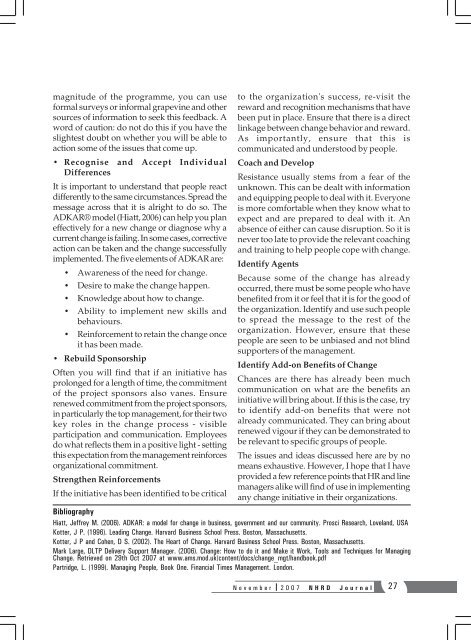NHRD Journal - National HRD Network
NHRD Journal - National HRD Network
NHRD Journal - National HRD Network
Create successful ePaper yourself
Turn your PDF publications into a flip-book with our unique Google optimized e-Paper software.
magnitude of the programme, you can use<br />
formal surveys or informal grapevine and other<br />
sources of information to seek this feedback. A<br />
word of caution: do not do this if you have the<br />
slightest doubt on whether you will be able to<br />
action some of the issues that come up.<br />
• Recognise and Accept Individual<br />
Differences<br />
It is important to understand that people react<br />
differently to the same circumstances. Spread the<br />
message across that it is alright to do so. The<br />
ADKAR® model (Hiatt, 2006) can help you plan<br />
effectively for a new change or diagnose why a<br />
current change is failing. In some cases, corrective<br />
action can be taken and the change successfully<br />
implemented. The five elements of ADKAR are:<br />
• Awareness of the need for change.<br />
• Desire to make the change happen.<br />
• Knowledge about how to change.<br />
• Ability to implement new skills and<br />
behaviours.<br />
• Reinforcement to retain the change once<br />
it has been made.<br />
• Rebuild Sponsorship<br />
Often you will find that if an initiative has<br />
prolonged for a length of time, the commitment<br />
of the project sponsors also vanes. Ensure<br />
renewed commitment from the project sponsors,<br />
in particularly the top management, for their two<br />
key roles in the change process - visible<br />
participation and communication. Employees<br />
do what reflects them in a positive light - setting<br />
this expectation from the management reinforces<br />
organizational commitment.<br />
Strengthen Reinforcements<br />
If the initiative has been identified to be critical<br />
to the organization's success, re-visit the<br />
reward and recognition mechanisms that have<br />
been put in place. Ensure that there is a direct<br />
linkage between change behavior and reward.<br />
As importantly, ensure that this is<br />
communicated and understood by people.<br />
Coach and Develop<br />
Resistance usually stems from a fear of the<br />
unknown. This can be dealt with information<br />
and equipping people to deal with it. Everyone<br />
is more comfortable when they know what to<br />
expect and are prepared to deal with it. An<br />
absence of either can cause disruption. So it is<br />
never too late to provide the relevant coaching<br />
and training to help people cope with change.<br />
Identify Agents<br />
Because some of the change has already<br />
occurred, there must be some people who have<br />
benefited from it or feel that it is for the good of<br />
the organization. Identify and use such people<br />
to spread the message to the rest of the<br />
organization. However, ensure that these<br />
people are seen to be unbiased and not blind<br />
supporters of the management.<br />
Identify Add-on Benefits of Change<br />
Chances are there has already been much<br />
communication on what are the benefits an<br />
initiative will bring about. If this is the case, try<br />
to identify add-on benefits that were not<br />
already communicated. They can bring about<br />
renewed vigour if they can be demonstrated to<br />
be relevant to specific groups of people.<br />
The issues and ideas discussed here are by no<br />
means exhaustive. However, I hope that I have<br />
provided a few reference points that HR and line<br />
managers alike will find of use in implementing<br />
any change initiative in their organizations.<br />
Bibliography<br />
Hiatt, Jeffrey M. (2006). ADKAR: a model for change in business, government and our community. Prosci Research, Loveland, USA<br />
Kotter, J P. (1996). Leading Change. Harvard Business School Press. Boston, Massachusetts.<br />
Kotter, J P and Cohen, D S. (2002). The Heart of Change. Harvard Business School Press. Boston, Massachusetts.<br />
Mark Large, DLTP Delivery Support Manager. (2006). Change: How to do it and Make it Work, Tools and Techniques for Managing<br />
Change. Retrieved on 29th Oct 2007 at www.ams.mod.uk/content/docs/change_mgt/handbook.pdf<br />
Partridge, L. (1999). Managing People, Book One. Financial Times Management. London.<br />
November 2007 <strong>N<strong>HRD</strong></strong> <strong>Journal</strong> 27
















